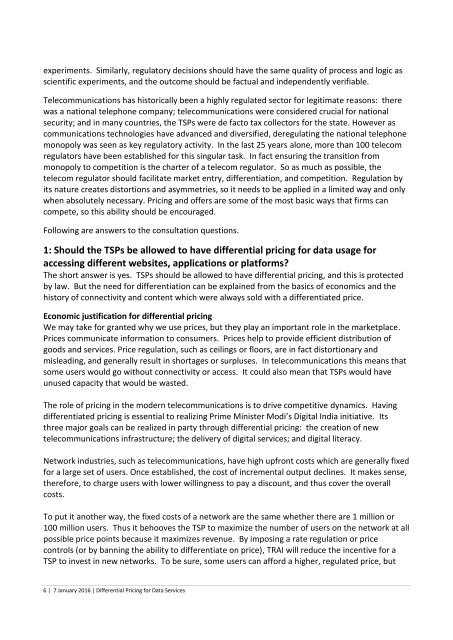Layton
Layton
Layton
You also want an ePaper? Increase the reach of your titles
YUMPU automatically turns print PDFs into web optimized ePapers that Google loves.
experiments. Similarly, regulatory decisions should have the same quality of process and logic as<br />
scientific experiments, and the outcome should be factual and independently verifiable.<br />
Telecommunications has historically been a highly regulated sector for legitimate reasons: there<br />
was a national telephone company; telecommunications were considered crucial for national<br />
security; and in many countries, the TSPs were de facto tax collectors for the state. However as<br />
communications technologies have advanced and diversified, deregulating the national telephone<br />
monopoly was seen as key regulatory activity. In the last 25 years alone, more than 100 telecom<br />
regulators have been established for this singular task. In fact ensuring the transition from<br />
monopoly to competition is the charter of a telecom regulator. So as much as possible, the<br />
telecom regulator should facilitate market entry, differentiation, and competition. Regulation by<br />
its nature creates distortions and asymmetries, so it needs to be applied in a limited way and only<br />
when absolutely necessary. Pricing and offers are some of the most basic ways that firms can<br />
compete, so this ability should be encouraged.<br />
Following are answers to the consultation questions.<br />
1: Should the TSPs be allowed to have differential pricing for data usage for<br />
accessing different websites, applications or platforms?<br />
The short answer is yes. TSPs should be allowed to have differential pricing, and this is protected<br />
by law. But the need for differentiation can be explained from the basics of economics and the<br />
history of connectivity and content which were always sold with a differentiated price.<br />
Economic justification for differential pricing<br />
We may take for granted why we use prices, but they play an important role in the marketplace.<br />
Prices communicate information to consumers. Prices help to provide efficient distribution of<br />
goods and services. Price regulation, such as ceilings or floors, are in fact distortionary and<br />
misleading, and generally result in shortages or surpluses. In telecommunications this means that<br />
some users would go without connectivity or access. It could also mean that TSPs would have<br />
unused capacity that would be wasted.<br />
The role of pricing in the modern telecommunications is to drive competitive dynamics. Having<br />
differentiated pricing is essential to realizing Prime Minister Modi’s Digital India initiative. Its<br />
three major goals can be realized in party through differential pricing: the creation of new<br />
telecommunications infrastructure; the delivery of digital services; and digital literacy.<br />
Network industries, such as telecommunications, have high upfront costs which are generally fixed<br />
for a large set of users. Once established, the cost of incremental output declines. It makes sense,<br />
therefore, to charge users with lower willingness to pay a discount, and thus cover the overall<br />
costs.<br />
To put it another way, the fixed costs of a network are the same whether there are 1 million or<br />
100 million users. Thus it behooves the TSP to maximize the number of users on the network at all<br />
possible price points because it maximizes revenue. By imposing a rate regulation or price<br />
controls (or by banning the ability to differentiate on price), TRAI will reduce the incentive for a<br />
TSP to invest in new networks. To be sure, some users can afford a higher, regulated price, but<br />
6 | 7 January 2016 | Differential Pricing for Data Services


